Laymans Guide to Phonak Roger Systems
Phonak Roger is a high quality wireless remote microphone system that effectively turbo charges the performance of hearing aids, bone anchored hearing aids and cochlear implants. It offers improvements in areas where hearing instruments alone can sometimes struggle to cope.

Phonak Roger systems help you to hear better in challenging environments – like when at work, when in social situations and in educational settings.
Roger helps in noisy situations, small groups and meetings – alleviating background noise, reverberation in the room, and overcoming distance to help you hear better.
A Phonak Roger system can also be used to interface with all manner of audio devices, like for instance telephony (including desk phones and PC based telephony and video conferencing software like Zoom and Microsoft Teams) and PC based accessibility software like Dragon, Texthelp, JAWS etc.
Roger can make life so much easier with mobile phones and tablets, Whatsapp and Facebook Messenger video calls, watching TV and much more.
Below is an overview of Phonak Roger in easy to understand language. If you want information or advice, please just get in touch!
Phonak Roger Transmitters
Phonak Roger On Transmitter
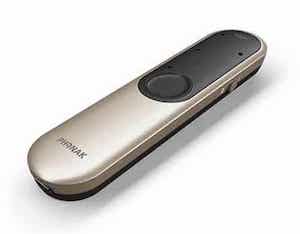
In the majority of cases the main (primary) transmitter in a Phonak Roger system is Phonak Roger On.
Phonak Roger On is an easy to use wireless microphone, intuitively it *just works*. It is just as efficient in Pointing mode (you direct who you want to hear and when), Presenter mode (when clipped to a speaker’s lapel or on a lanyard around their neck) and Table mode (where it is placed on a table to hear everyone in a small group).
It has a built in accelerometer and MultiBeam technology to ensure you get the full Roger Advantage, hearing the best you can in those challenging hearing situations.
Our recommendation is that a Roger On is absolutely fine for dealing with 1 to 1 situations, small groups, in noise and connecting to audio, including helping with telephony and TV.
You may need to consider additional or different Roger transmitters based on your individual needs and circumstances (as below) – if your requirements are greater.
Phonak Roger Table Mic Transmitter
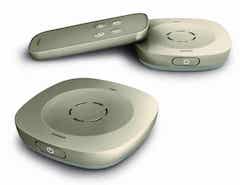
For larger meetings (say in a corporate environment) it may be more appropriate to consider additionally the Phonak Roger Table Mic which works really well on larger tables – typically a conference table. Depending on the area to be covered dictates the number of Table Mics required.
If you have a few people sat round a table a primary transmitter like Roger On is quite sufficient, but when the number of people round the table reaches near to and exceeds 7-8, then a Roger Table Mic becomes more of an appropriate solution – up to around 15 people.
When the number of people exceeds around 15 and up to say 25 we would consider a Twin Pack of Roger Table Mic to be the best solution.
If the meeting size is greater than 25 or people are spread about on multiple tables we suggest you have a conversation with us about suitability!
Phonak Roger Clip-on Mic Transmitter
There might be a scenario where there is a need for an additional secondary companion transmitter to work with your Roger On. In certain situations we could recommend Phonak Roger Clip-on Mic.
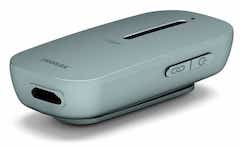
An example of when we might recommend an additional Roger Clip-on Mic (multiple units can be supplied to work in a network if appropriate, please ask if unsure) might be that you are attending a lecture, you want to hear the lecturer speaking at the podium a distance away, but still need to hear and interact with the people close to you.
The lecturer wears the Roger Clip-on Mic on their lapel so you can hear them clearly, and you still control the Roger On in your hand to enable you to hear the people close to you clearly as well.
Other Phonak Roger Transmitters

There are a number of additional Roger transmitters that we supply. The Roger Touchscreen Mic (image on the left) and its companion microphone, the Pass Around Mic are supplied mainly into educational settings and with room and group situations.
The Roger Select is available for people that need bluetooth connectivity to their Roger transmitter. (The legendary Roger Pen is discontinued). Roger On does not have this facility and relies on the inbuilt bluetooth connectivity in most of the newer hearing aids available, or the media cable supplied with all Phonak Roger primary transmitters.
Largely, Roger Select has been superseded by the newer Roger On transmitter that combines the best features of both the discontinued Pen and current Select.
Here are some product videos
Phonak Roger Receivers
When a Phonak Roger transmitter collects audio (like a person’s voice you want to hear, or an audio source like a phone call), it wirelessly and securely transmits that audio to a Roger receiver (or a pair of receivers) that then sends the audio (with some technical whizzery pokery while it is processing the audio to enhance the signal) directly into your hearing instruments, sometimes via some kind of interface.
Broadly you can split the way transmitted Roger audio is received into two main methods – at ‘ear level’ and ‘neck worn’. Our preference where it is possible is for ‘ear level’ as it is more efficient, less chance of interference and highest quality.
Phonak Roger Ear Level Receivers
The most common type of ear level Roger receiver we supply is a Roger X receiver, and using a DAI (Direct Audio Input) shoe as an interface between the hearing aid and the Roger audio signal.
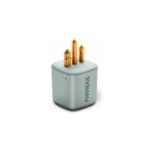 Roger X conveniently clips neatly and discreetly to the bottom of your hearing aids along with a DAI shoe (one for each ear and if you wear BTE ‘behind the ear’ hearing aids).
Roger X conveniently clips neatly and discreetly to the bottom of your hearing aids along with a DAI shoe (one for each ear and if you wear BTE ‘behind the ear’ hearing aids).
Most NHS issue hearing aids (older Phonak, Signia, ReSound Danalogic and Oticon typically) accept a DAI shoe and Roger X receiver. Roger X is universal and the DAI shoe is dependent on the brand and model of hearing aid.
You can wear a neck worn receiver with nothing clipped to your hearing aids, but mostly and where we can, we advise that people use ear level receivers as the first, best choice.
Roger Integrated and Roger Direct
Often cochlear implant processors have integrated receivers available (a combined DAI shoe and Roger receiver) that are specially designed to work with specific models, matching in design and colour.
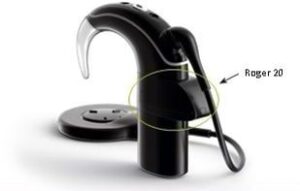 This image shows a Cochlear Nucleus processor with a colour coded Roger 20 integrated receiver attached.
This image shows a Cochlear Nucleus processor with a colour coded Roger 20 integrated receiver attached.
For newer Roger Direct compatible hearing aids from Phonak – Marvel, Paradise, Lumity, Infinio, newer NHS supplied Phonak Nathos Nova, also Unitron DX / Blu, and Specsavers Advance x70… a great option is your Phonak Roger transmitter streaming audio wirelessly DIRECT into the hearing aids with NO external Roger receivers.
Phonak Roger Neck Worn Receivers
Another alternative to streaming audio direct from a Roger transmitter direct to ear is via a neckloop or lapel mic setup. Direct to ear solutions tend to be the best solution for most scenarios but sometimes they are not available or suitable.
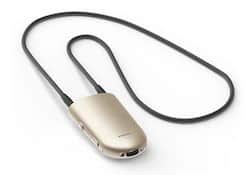
Roger Neckloop receives audio from a Roger transmitter and converts it to a telecoil audio signal (loop) to be received by the telecoil (T position) of the hearing instrument.
It is a simple, straightforward solution but can sometimes be prone to interference with strong electrical and wifi sources, also other loop systems in the vicinity. The audio bandwidth is also narrower due to using telecoil for part of the transmission of sound but is quite adequate for speech intelligibility. A good alternative if ‘direct to ear’ is not available.
![]()
Another alternative to consider if ear level receivers are not available is a streamer / lapel mic bundle.
Most hearing aids and cochlear implant processors are wireless compatible and can make use of something generically called a ‘streamer’. In some instances (not all) streamers and lapel mics have an audio interface with three little sockets called europlug.
You can plug a Roger X universal receiver into this socket, and with the combination of a Roger transmitter, a Roger X and a streamer you have an alternative way of using Phonak Roger with hearing instruments.
Take Home Point : We usually recommend in this order – Direct to Ear, Streamer Bundle, Roger Neckloop.
Summary
If you need our advice we absolutely need the brand AND model of hearing instruments you are using. If you are interested in specific products let us know. We need to know the situations you are struggling with. What you are aiming to achieve.
With BTE (behind the ear) hearing aids we need the detail that is printed on the spine of the aids. ITE (in the ear) hearing aids, bone anchored hearing aids and cochlear implants ideally we need the serial numbers printed on the casing or listed on your paperwork. Tip – If unsure take a clear and unblurred picture on your mobile phone and email it across to us.
You can email us with as much detail as possible regarding your requirements if you are sure you know what you want / need, and if you are still a little unsure of what you specifically need we suggest you complete our Product Guidance Questionnaire. Once completed we will email you a comprehensive breakdown of products and prices.
N.B. If the equipment is for personal use with no business element and paid for out of personal funds your purchase may be supplied free of VAT. Please read this if you think this may apply.
